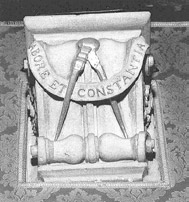Tyndale International Conferences
Tyndale’s Testament Exhibition, Antwerp 2002.

The symbol adopted by Plantin in 1557: the golden compasses and the motto Labore et Constantia
The 4th International Tyndale Conference will include the formal opening of the exhibition ‘Tyndale’s Testament’, in the UNESCO-listed Museum Plantin-Moretus in Antwerp. The opening itself will take place in the Cathedral of Our Lady in Antwerp on Monday 2 September at 5.30pm.
The exhibition provides glimpses of the humanist learning available to Tyndale, the Antwerp context in which most of his work was done, and the transformation of scriptural piety in the era of the early Reformation. The exhibits also include documents relating to Tyndale’s imprisonment and trial, especially his prison letter, and the only complete copy of the Worms New Testament, from the Wuerttembergische Landesbibliothek in Stuttgart. A short introductory section gives an overview of Tyndale’s posthumous reputation, from Foxe’s Book of Martyrs to the quincentenary celebrations of 1994, for those not yet acquainted with his importance.
The initial response of those in authority to evangelical reformation in England, France and Denmark made Antwerp an important location for printing dissident religious works to be shipped to those countries, as well as being a vibrant centre of cultural life in the Low Countries of Charles V. Tyndale (all of whose works, except the Cologne Fragment and the Worms New Testament, were first printed in Antwerp) was a small part of a big scene, which saw the publication of the Dutch Liesvelt Bible (Antwerp, 1526), the French Bible attributed to Jacques Lefèvre d’Etaples (Antwerp, 1530) and the English Coverdale Bible (Antwerp ? 1535), the first complete bibles in print in their respective languages. Tyndale was a man whose longterm impact was to be greater than that of any of those around him.
The richly illustrated, hardback exhibition catalogue will be available to conference attendees at the special price of 26 euros. It includes an introduction on the Antwerp book trade by Francine de Nave, an overview of Tyndale’s contribution to the English language and culture by Guido Latré, an essay by Gergely Juhász on the versions of the Bible available in the early Reformation and how they were put to use, and essays by Andrew Hope on sixteenth-century book smuggling and on the precipitate nineteenthcentury rejection of Antwerp as the place of printing of the Coverdale Bible. It also includes several short contributions by Jean-François Gilmont on the French Bible translations printed in Antwerp, and by Gilbert Tournoy on humanist critical and linguistic scholarship, scholars of international renown in their respective fields.
The concept of the exhibition was developed through a research project headed by Professor Guido Latré of the KU Leuven and of the Université Catholique de Louvain. Professor Jean-François Gilmont of the UCL is associated with the project and Andrew Hope has worked on the project team, which also includes the young scholars Gergely Juhász and Paul Arblaster.